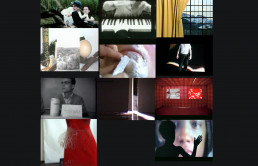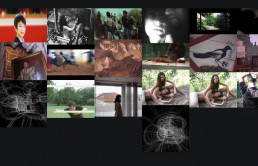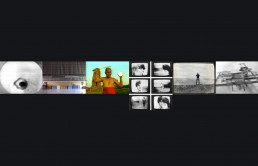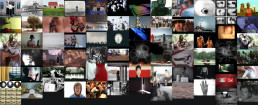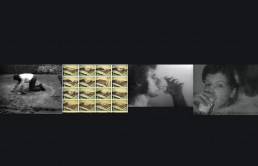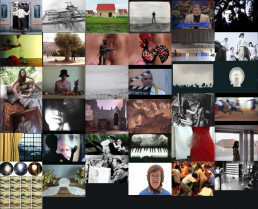FUSO 2010 – Programa 28 Julho, 23h30
BES Arte & Finança
Open Call
CARPE DIEM Arte e Pesquisa
1ª Sessão de projeção competitiva do Open Call do FUSO 2010 aos artistas portugueses, com seleção de Elsa Aleluia
Duração total da projeção 59’46’’
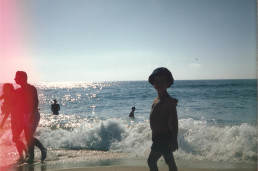
Miguel Bonneville, Landscape of Faillure, Portugal, 4’10’’
Inevitavelmente ligado a uma sensação de liberdade e a um sentimento de desespero. Inevitavelmente ligado a ti. A obrigatoriedade. A impossibilidade. Haverá sempre esta ligação entre ela, tu e eu. Haverá sempre um trauma que me ligará a ti. E hoje. Treze anos depois. Hoje posso aproximar-me do mar sem teres que me dar a mão ou levares-me aos ombros. Posso ver refletida nele uma paisagem de fracassos que reconheço e a que me dedico repetidamente.
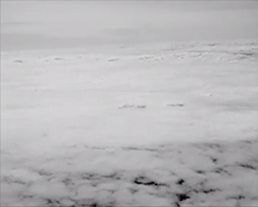
Marta Alvim, Devir/To Become, Portugal, 3’08’’
Em Devir/To Become diferentes estados de consciência são representados numa viagem entre a abstração e a realidade. Durante o processo podemos observar uma descida entre níveis de consciência provocada pela interferência dos sons do local onde o corpo físico se encontra. Imerso na atmosfera de um daydream, o espectador envolve-se num novo estado de percecionar e de existir. Nesta obra viajamos por entre lugares da mente, onde uma nova forma de linguagem permite uma diferente compreensão do conceito de tempo e de espaço.

Luís Sezões, Resposta ao Meireles, Portugal, 2’53’’
Onde se enquadra a contracultura nos dias de hoje? Se, nos tempos em que esta expressão começou a ser utilizada, a contracultura e a cultura mainstream andavam em polos opostos, hoje em dia namoram pelas esquinas. Em 1970, Cildo Meireles com as suas “Inserções em Circuitos Ideológicos”, desenvolveu o projeto “Coca-Cola”, que consistia no uso do processo de silkscreen com tinta branca vitrificada sobre garrafas de Coca-Cola (símbolo indiscutível do capitalismo norte-americano). Com esses decalques eram inscritas mensagens, sendo que uma delas eram instruções em como fazer daquele objeto de vidro um cocktail Molotov (símbolo da contracultura e revolta). Se naquela altura o inverter a conotação de um objeto, conferindo a ícones mainstream uma conotação subversiva, era um exercício comum desenvolvido por certos grupos sociais, atualmente testemunha-se o contrário. Já não são os punks ou os anarquistas ou os hippies a alterarem certos objetos e marcas de uma forma subversiva, mas sim essas mesmas marcas a utilizarem a estética rebelde, convertendo-a ao mainstream. Não faltam exemplos. Moicanos em meninos ricos, calças rasgadas ao dobro do preço de calças por rasgar, bandas punk que alcançam sucesso com a MTV, festivais onde se “promove” a rebeldia e a individualidade à sombra de lonas publicitárias de desodorizante, refrigerante e telemóveis. Este vídeo, intitulado Resposta ao Meireles, joga com esses conceitos. O que se pretende é o revisitar de uma experiência de subversão de um ícone capitalista, trocando-lhe a função, colocando-o ao serviço do outro lado da barricada. Para tal o que se apresenta no vídeo é exatamente a materialização da sugestão de reutilização da garrafa de refrigerante que Meireles disponibilizou em 1970 com o projeto “Coca-Cola”.
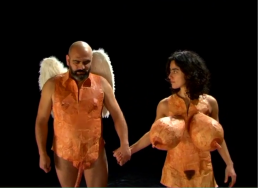
Andrea Inocêncio, Ai! Má Companhia #1, Portugal, 4’51’’
Duas células handicapadas, Alama & Butifarra, mostram como o canibalismo é a origem da sexualidade.
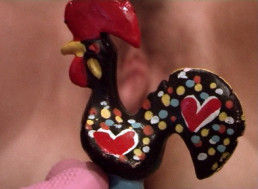
Clara Games, Hunger, Portugal, 5’
No século XXI a crítica da sociedade de consumo é dada como anacrónica pelas formas de arte dominantes. Num mundo onde o consumismo atingiu formas e níveis nunca vistos, a arte tende a tratá-lo como objeto esgotado. Esta vídeo-performance é uma alegoria do consumo e da própria crítica do consumo: uma vulva come vários objetos, uns simbólicos, outros, ícones do consumo em si. Sendo o sexo um dos produtos mais consumidos atualmente, foi escolhido como o objeto principal desta performance. É, porém, descontextualizado através de uma distância que anula o seu sentido erótico. Certas palavras são introduzidas como separadores e parecem ora sublinhar, ora ironizar, os objetos. Numa época em que a própria arte multimédia se submete aos efeitos do consumismo (frequentemente avalia-se a técnica e não o resultado) procurámos, através da simplicidade de três instrumentos já muito explorados, mas sempre abertos – o corpo/performance, o vídeo e a palavra – o máximo efeito estético e significante.
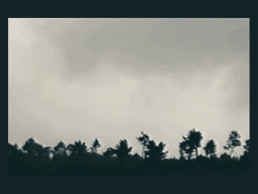
Alexandre Reigada, Screen Test, Portugal, 7’51’’
O artista, ele mesmo, num território performativo, conta-nos uma história. Facto ou Ficção?
Screen Test é um primeiro plano, desenho prévio, um esboço de filme sobre a ilusão de tempo e espaço na narrativa. Impresso a preto e branco, entre o silêncio ou uma voz distorcida e etérea, descreve um universo composto de singularidade e entropia. Emerge uma trama misteriosa em ambiente urbano, num eixo Lisboa/Berlim. O enredo surge condensado, a forma depurada até ao concreto. Mistura emocional de film noir com cinema mudo, a vídeo-poesia com o moderno e excitante preview de cinema, onde o sonho se transforma em consciência e desejo. Através de uma série de sequências-síntese visuais unificadas por um texto, o trabalho foca-se sobre o crescimento orgânico de uma ideia, de uma visão. Aqui, onde a superfície digital é tratada como conteúdo e matéria pictórica. Aqui, a palavra define o tom e a verdade transitória da imagem.

Filipe André Alves, Para ser Grande sê Inteiro, Portugal, 4’35’’
Neste trabalho, “transcrevi” a estranheza inquietante tratada em todo o trabalho de Fernando Pessoa. Peguei assim na estátua do poeta, algo de bastante conhecido. Desconstruí, tornei-a abstrata (grande/inteira), dei-lhe uma nova perspetiva de observação, como se estivesse a ser vista em detalhe, ao pormenor. Está a ser observada pela primeira vez de forma clínica com a estranheza inquietante merecida. Com esta tentativa de exploração metafísica tento abordar variados tipos de causa, entre a forma e matéria, a existência do objeto, examino o que pode ser afirmado sobre qualquer coisa que existe apenas pela sua existência.
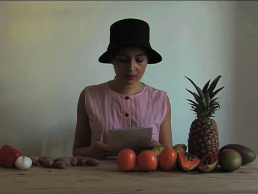
Prémio Aquisição PLMJ
Raquel Schefer, Avó (Muidumbe), Portugal, 10’49’’
Uma sequência de material de arquivo familiar é o ponto de partida de um vídeo sobre a minha relação com um território imaginário – a vila de Muidumbe, em Moçambique, em 1960, então administrada pelo meu avô. Transformo-me gradualmente na minha avó para explorar e desconstruir os lapsos discursivos entre o texto (cartas familiares), memórias pós-coloniais e imagem de arquivo, procurando os traços de um território (ou de um desejo de territorialização) obsessivo.
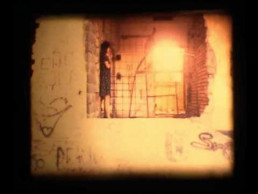
Mara Castilho, Walking the Line between West and East, Portugal, 1’04’’
Walking the Line between West and East é a primeira parte de uma série de “caminhadas” realizadas pela artista numa viagem do Oeste da Europa para a Europa de Leste. Filmado entre 1999 e 2005, a artista percorre o caminho de uma Europa em transição. Um traçado entre a derrocada do muro de Berlim, o desmoronamento da União Soviética e a sangrenta desagregação da Jugoslávia. Walking the Line between West and East – parte 1, foi filmada na Polónia, onde os muros refletiam a transição política de um país após a queda do regime comunista.
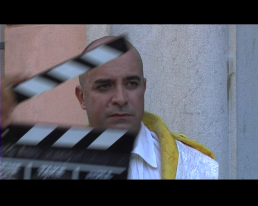
Joana Dilão & Noële Georg, Kings and Queens and Lovers, Portugal, 11’37’’
“Only yesterday there were kings here… Kings and queens, warriors and lovers, all kinds of real human beings living all the real human emotions. Yesterday I sold this land, and now they are going to build a 5 and 10 cent store Prisunic on this… this, my last kingdom!”
O Desprezo (Jean-Luc Godard, 1963)
Kings and Queens and Lovers é uma instalação de vídeo sobre o cinema, as imagens e a representação que toma como ponto de partida uma cena de O Desprezo, de Jean-Luc Godard. Um rei e uma rainha passeiam-se pelas ruas do Lumiar, junto aos estúdios da Tóbis, onde antes havia quintas e espaços verdes e agora se erguem prédios suburbanos. Dois amantes conversam dentro de um café que tem na parede uma fotografia a preto e branco a abrir outra perspetiva sobre esses mesmos estúdios. As quatro personagens dão voz a um texto construído a partir de um conjunto de reflexões e especulações de cineastas sobre o seu trabalho.
Carlos Godinho, Test Video, Portugal, 5’48’’
Pessoas espalhadas pelo mundo inteiro partilham, através da internet os testes que fizeram às suas próprias câmaras de vídeo. Partindo de uma recolha destes vídeos, criei uma viagem a partir da visão, aumentada tecnologicamente, que as pessoas têm neste planeta.
BES Arte & Finança
July 28th, 11:30pm
Open Call
CARPE DIEM Arte e Pesquisa
1st Competitive screening session of FUSO 2010’s Open Call to Portuguese artists, works selected by Elsa Aleluia
Total running time 59’46’’

Miguel Bonneville, Landscape of Faillure, Portugal, 4’10’’
Inevitably connected to a sensation of freedom and to a feeling of despair. Inevitably connected to you. A compulsory nature. An impossibility. There will always be this connection between her, you and me. There will always be a trauma that will connect me with you. Today, thirteen years later. Today I can get close to the sea without having to hold your hand or be taken sitting on your shoulders. I can see a landscape of failures that I recognize reflected upon it and to which I dedicate myself repeatedly.

Marta Alvim, Devir/To Become, Portugal, 3’08’’
In Devir/To Become different levels of consciousness are represented as a journey from abstraction to reality.
During this process, image suggestion and no synchronicity lead the viewer through the understanding of different states of perception and existence.
Immersed in a dreaming/awake atmosphere, the viewer notices an alternate state of consciousness influenced by the sounds of the surrounding reality.
This contamination creates a different comprehension of time and space and a new atmosphere of places and languages.

Luís Sezões, Resposta ao Meireles, Portugal, 2’53’’
Where does the counterculture fit today? If, in the days when this term began to be used, counterculture and mainstream culture were at opposite sides, today they flirt around the corners.
In 1970, Meireles with his Insertions into Ideological Circuits, developed the Coca-Cola project, which consisted in using the process of silkscreen with white glazed ink on bottles of Coca-Cola (undisputed symbol of the north-American capitalism). With that technique he left messages on the bottles, and one of them was an instruction on how to turn that glass object into a Molotov cocktail (a symbol of counterculture and rebellion). If at that time, reversing the connotation of an object, giving mainstream icons subversive connotations, was a common exercise carried out by certain groups, today it’s witnessed the opposite. There are no longer anarchists or punks or hippies to modify certain objects and brands into a subversive way, but there are those brands to use the rebel aesthetic, turning it into the mainstream. There are many examples. Rich kids with mohawks, ripped pants cost twice than non-ripped ones, “punk” bands who achieve success through MTV and youth festivals where rebellion and individuality are promoted under the shade of the canvas, advertising deodorant, soft drinks and mobile phones. This video, entitled Resposta ao Meireles (Response to Meireles) plays with these concepts. The aim is to revisit the experience of subverting a capitalist icon, changing its function, putting it on the other side of the barricade. What is presented in the video is exactly the embodiment of the suggestion to reuse the soda bottle that Meireles released in 1970 with the project Coca-Cola.

Andrea Inocêncio, Ai! Má Companhia #1, Portugal, 4’51’’
Two handicapped cells, Alama & Butifarra show how cannibalism is the origin of sexuality.

Clara Games, Hunger, Portugal, 5’
This video-performance is an allegory of consumption and on the critique of consumption at the same time: a vulva eats several objects, some symbolic, others, icons of consumption itself.
Being sex one of the most consumed products of today, it was chosen as the main object of this performance. However, it is decontextualized through a distance that abolishes its erotic meaning.
When multimedia art submits itself to the effects of consumerism (frequently what is evaluated is the technique, not the result), I searched for the best significant and esthetical effect through three very used but still very opened tools – body/performance, video and word.

Alexandre Reigada, Screen Test, Portugal, 7’51’’
He himself, the artist, tells us a story on performative territory. Fact or Fiction?
Screen Test is a first plan, first drawing, a film-sketch about the illusion of time and space on the narrative. Printed in black and white, between the silence or a distorted ethereal voice that describes a universe made of singularity and emerge a mysterious plot on an urban environment, on a Lisbon/Berlin axle. The condense intrigue, the form depurated as far as the concrete.
Mixed emotions of film noir with silent film, video poetry and the modern stimulating cinema preview, where the dream becomes consciousness and desire.
Through a series of visual sequence-synthesis, unified by a script, the work focus on the organic growing of an idea, or a vision.
Here, where digital surface is treated as content and pictorial material. Here, word defines the tone and the transitory image’s truthfulness.

Filipe André Alves, Para ser Grande sê Inteiro, Portugal, 4’35’’
In this work, I “transcribed” the disturbing strangeness treated in all of Fernando Pessoa’s work. Thus I took the statue of the poet, something well known. I deconstructed it, made it abstract (in large/whole), gave it a new perspective of observation, as if it were to be seen in detail. It is being clinically observed for the first time with the strangeness it deserves. With this attempt of metaphysical exploration, I try to address several causes, between form and matter, the existence of the object, I examine what can be affirmed about anything that exists only by its existence.

PLMJ Acquisition Award
Raquel Schefer, Avó (Muidumbe), Portugal, 10’49’’
A portrait of a colonial family in Mozambique, an ex-Portuguese colony in 1960. An 8mm sequence of family related footage is the point of departure of an experimental documentary about my relationship with an imaginary territory – the town of Muidumbe, in the 60’s Mozambique, just before the beginning of the Colonial War, where my family used to live and my grandfather was the Head of the Administrative Post. “Avó (Muidumbe)” portrays my gradual transformation into my grandmother as an aim to explore and deconstruct the discursive lapses between text (family letters), postcolonial memories and archive imagery, searching for the signs of an unknown obsessive territory.

Mara Castilho, Walking the Line between West and East, Portugal, 1’04’’
Walking Line Between East and West – Part 1 is the first part of a series of walks made by the artist during a journey on the Western Europe to the Eastern. Filmed between 1999 and 2005, the artist travels the path of a Europe in transition. A route between the fall of the Berlin Wall, the collapse of the Soviet Union and the bloody disintegration of Yugoslavia. This film was shot in Poland, where the walls reflect the transition from one country after the fall of communism. This work is originally filmed in Super-8.

Joana Dilão & Noële Georg, Kings and Queens and Lovers, Portugal, 11’37’’
“Only yesterday there were kings here… kings and queens, warriors and lovers, all kinds of real human beings living all the real human emotions. Yesterday I sold this land, and now they are going to build a 5 and 10 cent store Prisunic on this… this, my lost kingdom!”
Le Mépris, 1963
Kings and Queens and Lovers is a video installation about cinema, the images and formal representation which takes has a starting point a scene from Jean-Luc Godard’s “Contempt (Le Mépris)”.
A king and a queen stroll around the streets of Lumiar, in the surroundings of Tóbis film studios, where once there were farms and green spaces and now stand suburban buildings. Inside a café, two lovers talk. Hung on a wall, a black and white photograph opens another viewpoint to those same studios. The four characters give voice to a text that builds on a series of reflections and speculations from cineastes about their work.
Carlos Godinho, Test Video, Portugal, 5’48’’
All over the world, people share their own video camera tests throughout the internet. Using a selection of these videos, I created a journey based on the technologically enlarged vision that people have on this planet.
